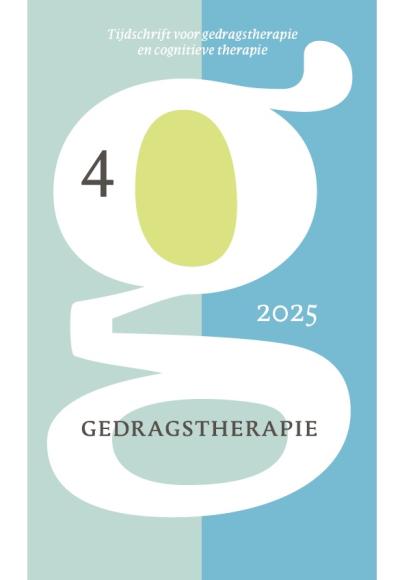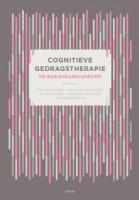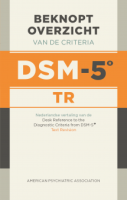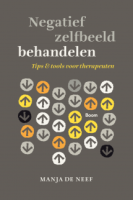Inhoud
Acceptatie en commitment therapie (ACT) in een groep voor de paniekstoornis met en zonder agorafobie. Een pilot-studie naar werkzaamheid en de voorspellende waarde van acceptatie
Samenvatting
In dit artikel wordt een pilotstudie beschreven naar de werkzaamheid van Acceptatie en Commitment Therapie bij de paniekstoornis met en zonder agorafobie. De behandeling werd gegeven aan cliënten in een groep (N=40). ACT bleek een effectieve behandeling voor de paniekstoornis te zijn. De angst voor lichamelijke sensaties nam af, evenals agorafobisch vermijdingsgedrag. De resultaten waren vergelijkbaar met de uitkomsten van een eerder gegeven CGT-groepsbehandeling voor dezelfde klachten. Voorts werd onderzocht of een klinische verbetering verband hield met veranderingen in acceptatie van gevoelens, gedachten en lichamelijke sensaties. Dit bleek zo te zijn. Eerdere veranderingen in acceptatie voorspelden echter geen latere veranderingen in ernst van de klachten. De pilot-studie kende helaas wel enkele substantiële methodologische tekortkomingen.
Literatuur
- American Psychiatric Association (2001). Diagnostic and Statistical Manual of Mental disorders: IV. Washington DC: American Psychiatric Association.
- Arrindell, W.A., & Ettema, J.H.M. (2005). SCL-90. Handleiding bij een multidimensionale psychpathologie-indicator. Amsterdam: Pearson.
- Arts, W. (2008). Acceptance and Commitment Therapy voor intrusies. Directieve Therapie, 28, 163-186.
- Arts, W., Akkermans, M., Kromhout, J., & Rouwendal, E. (1997). Cognitieve gedragstherapie in een groep voor cliënten met een paniekstoornis en agorafobie. Directieve therapie, 17, 343-358.
- Belfer, P.L., Munoz, L.S., Schachter, J., & Levendusky, P.G. (1995). Cognitive-behavioural group psychotherapy for agoraphobia and panic disorder. International Journal of Group Psychotherapy, 45, 185-206.
- Beurs, E. de (1993). The assessment and treatment of panic disorder with agoraphobia. Amsterdam: Thesis Publishers.
- Beurs, E. de, Dyck, R. van, Balkom, A.J.L.M. van, Lange, A., & Koele, P. (1994). Assessing the clinical significance of outcome in agoraphobia research: a comparison of two approaches. Behavior Therapy, 25, 147-158.
- Bond, F.W., & Brunce, D. (2003). The role of acceptance and job control in mental health, job satisfaction, and work performance. Journal of Applied Psychology, 88, 1057-1067.
- Block, J.A. (2002). Acceptance or change of private experiences: A comparative analysis in college students with public speaking anxiety. Dissertation Abstracts International: Section B: the Sciences and Engineering. Vol 63(9-B).
- Brown, K.W., & Ryan, R.M. (2003). The benefits of being mindful: Mindfulness and its role in psychological well-being. Journal of Personality and Social Psychology, 84, 822–848.
- CBo (2009). Richtlijnherzieningen van de Multidisciplinaire Richtlijn Angststoornissen bij volwassenen. Utrecht: Trimbos-instituut.
- Chambless, D.L., Caputo, G.C., Bright, P., & Gallagher, R. (1984). Assessment of fear in agoraphobics: the Body Sensation Questionnaire and the Agoraphobic Cognitions Questionnaire. Journal of Consulting and Clinical Psychology, 52, 1090–1098.
- Chambless, D.L., Caputo, G.C., Jasin, S.E., Gracely, E.J., & Williams, C. (1985). The Mobility Inventory for agoraphobia. Behaviour Research and Therapy, 23, 35-44.
- Cohen, J. (1988). Statistic al power analysis for the behavioral sciences. Hillsdale NJ: Erlbaum.
- Craske, M.G. (1999): Anxiety Disorders. Psychological approaches to theory and treatment. Boulder, Westview Press.
- Derogatis, L.R., Lipman, R.S., & Covi, L. (1973). SCL-90, an outpatient psychiatric rating scale-preliminary report. Psychopharmacology Bulletin, 9, 13-28.
- Eifert, G.H., & Forsyth, J.P. (2005). Acceptance & Commitment Therapy for Anxiety Disorders – A Practitioner's Treatment Guide to Using Mindfulness, Acceptance, and ValuesBased Behavior Change Strategies. oakland: New Harbinger Publications.
- Eifert, G.H., & Heffner, M. (2003). The effects of acceptance versus control contexts on avoidance of panic-related symptoms. Journal of Behavior Therapy and Experimental Psychiatry, 34, 293-312.
- Emmelkamp, P.M.G. (2004). Behavior therapy with adults. In: M. Lambert (Ed.): Bergin & Garfield's Handbook of psychotherapy and behavior change (pp. 393-446). 5th Edition. New York: John Wiley and Sons.
- Emmelkamp, P.M.G., Hoogduin, C.A.L., & Hout, M.A. van den (2000). Angststoornissen. In: W. Vandereyken, C.A.L. Hoogduin & P.M.G. Emmelkamp (Eds..): Handboek psychopathologie deel 1. Houten: Bohn, Stafleu Van Loghum.
- Finkel, S.E. (1995). Causal analysis with panel data. Thousands oaks, CA: Sage.
- Foa, E.B., & Emmelkamp, P.M.G. (1983). Failures in behavior therapy: New York: Wiley.
- Foa, E.B., & Kozak, M.J. (1997a). Beyond the efficacy ceiling? Cognitive behavior therapy in search of a theory. Behavior Therapy, 28, 601-611.
- Forman, E.M., Herbert, J.D., Moitra, E., Yeomans, P.D., & Geller, P.A. (2007). A randomized controlled effectiveness trial of acceptance and commitment therapy and cognitive therapy for anxiety and depression. Behavioral Modification, 31, 772-799.
- Gutiérrez, o., Luciano, C., Rodríguez, M., & Fink, B. C. (2004). Comparison between an acceptance-based and a cognitive-control-based protocol for coping with pain. Behavior Therapy, 35, 767–783.
- Hayes, S.C., Barnes-Holmes, D., & Roche, B. (2001). Relational Frame theory: A post-Skinnerian account of human language and cognition. New York: Kluwer-Plenum.
- Hayes, S.C., Luoma, J.B., Bond, F.W., Masuda, A., & Lillis, J. (2006). Acceptance and commitment therapy: Model, processes and outcomes. Behaviour Research and Therapy, 44, 1-25.
- Hayes, S.C., Masuda, A., Bissett, R., Luoma, J., & Guerrero, L.F. (2004). DBT, FAP, and ACT: How empirically oriented are the new behavior therapy technologies? Behavior Therapy, 35, 35-54.
- Hayes, S.C., Strosahl, K.D., & Wilson, K.G. (1999). Acceptance and Commitment Therapy: An experiential approach to behavior change. New York: Guilford Press.
- Hayes, S.C. Strosahl, K.D., Wilson, K.G., Bissett, R.T., Pistorello, J., Toarmino, D., Polusny, M.A., Dykstra, T.A., Batten, S.V., Bergan, J., Stewart, S.H., Zvolensky, M.J., Eifert, G.H. Bond, F.W., Forsyth, J.P., Karekla, M., & McCurry, S.M. (2004). Measuring experiential avoidance: A preliminary test of a working model. The Psychological Record, 54, 553 – 578.
- Jacobs, N., Kleen, M. Blokzijl, R., De Groot, F., & A-Tjak, J. (2008). Het meten van experiëntiële vermijding. De Nederlandstalige versie van de Acceptance and Action Questionnaire-II (aaq-ii). Gedragstherapie, 41, 349–361.
- Jacobson, N.S., & Truax, P. (1991). Clinical significance: A statistical approach to defining meaningful change in psychotherapy research. Journal of Consulting and Clinical Psychology, 59, 12-19.
- Karekla, M., Forsyth, J.P., & Kelly, M.M. (2004). Emotional avoidance and panicogenic responding to a biological challenge procedure. Behavior Therapy, 35, 725-746.
- Lambert, M.J., Hansen, N.B., & Bauer, S. (2008). Assessing the clinical significance of out come results. In A. Nezu & C.M. Nezu (Eds.). Evidence-based outcome research: A practical guide to conducting randomized controlled trials for psychosocial interventions (pp. 359-378). New York: oxford University Press.
- Levitt, J.T., Brown, T.A., orsillo, S.M., & Barlow, D.H. (2004). The effects of acceptance versus suppression of emotion on subjective and psychophysiological response to carbon dioxide challenge in clients with panic disorder. Behavior Therapy, 35, 747–766.
- Mitte, K (2005). A meta-analysis of the efficacy of psycho- and pharmacotherapy in panic disorder with and without agoraphobia. Journal Of Affective Disorders, 88, 1, 27-45.
- Öst, L. (2008). Efficacy of the third wave of behavioral therapies: A systematic review and meta-analysis. Behaviour research and therapy, 46, 296 – 321.
- Power, M.B., Zum Vörde Sive Vörding, M.B., & Emmelkamp, P.M.G. (2009). Acceptance and commitment therapy: a meta-analytic review. Psychotherapy and Psychosomatics, 78, 73-80.
- Pull, C.B. (2008). Current empirical status of acceptance and commitment therapy. Current opinion in Psychiatry, 22, 55-60.
- Purdon, C. (1999). Thought suppression and psychopathology. Behaviour Research and Therapy, 37, 1029–1054.
- Sharp, D.M., Power, K.G., & Swanson, V. (2004). A comparison of the efficacy and acceptability of group versus individual cognitive behaviour therapy in the treatment of panic disorder and agoraphobia in primary care. Clinical Psychology and Psychotherapy, 11, 37 – 82.
- Twohig, M.P., Hayes, S.C., & Masuda, A. (2006). Increasing willingness to experience obsessions: Acceptance and Commitment Therapy as a treatment for obsessive compulsive disorder. Behavior Therapy, 37, 3 –13.
- Zettle, R.D. (2003). Acceptance and commitment therapy (ACT) vs. systematic desensitization in treatment of mathematics anxiety. Psychological Record. 53, 197-215.
 © 2009-2025 Uitgeverij Boom Amsterdam
© 2009-2025 Uitgeverij Boom Amsterdam
De artikelen uit de (online)tijdschriften van Uitgeverij Boom zijn auteursrechtelijk beschermd. U kunt er natuurlijk uit citeren (voorzien van een bronvermelding) maar voor reproductie in welke vorm dan ook moet toestemming aan de uitgever worden gevraagd:
Behoudens de in of krachtens de Auteurswet van 1912 gestelde uitzonderingen mag niets uit deze uitgave worden verveelvoudigd, opgeslagen in een geautomatiseerd gegevensbestand, of openbaar gemaakt, in enige vorm of op enige wijze, hetzij elektronisch, mechanisch door fotokopieën, opnamen of enig andere manier, zonder voorafgaande schriftelijke toestemming van de uitgever.
Voor zover het maken van kopieën uit deze uitgave is toegestaan op grond van artikelen 16h t/m 16m Auteurswet 1912 jo. Besluit van 27 november 2002, Stb 575, dient men de daarvoor wettelijk verschuldigde vergoeding te voldoen aan de Stichting Reprorecht te Hoofddorp (postbus 3060, 2130 KB, www.reprorecht.nl) of contact op te nemen met de uitgever voor het treffen van een rechtstreekse regeling in de zin van art. 16l, vijfde lid, Auteurswet 1912.
Voor het overnemen van gedeelte(n) uit deze uitgave in bloemlezingen, readers en andere compilatiewerken (artikel 16, Auteurswet 1912) kan men zich wenden tot de Stichting PRO (Stichting Publicatie- en Reproductierechten, postbus 3060, 2130 KB Hoofddorp, www.cedar.nl/pro).
No part of this book may be reproduced in any way whatsoever without the written permission of the publisher.
Inloggen VGCt en VVGT
Leden van de VGCt en de VVGT loggen in via de site van hun vereniging. Als u op die site bent ingelogd als lid, vindt u daar een button naar het Tijdschrift voor Gedragstherapie.
English
Behavioral Therapy: Journal for Behavioral Therapy and Cognitive Therapy ISSN 0167-7454
Information in English can be found here.







